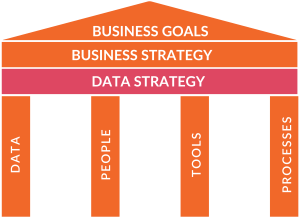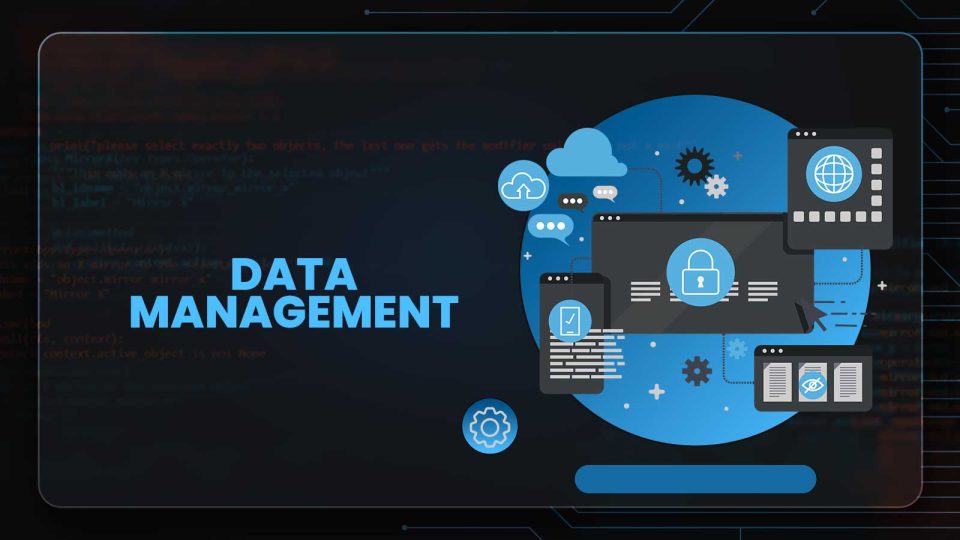Data is a pivotal asset for organizations, underpinning business value and competitive advantage. Chief Information Officers (CIOs) are not just custodians of technology infrastructure but strategic drivers tasked with harnessing data for growth and innovation. This shift requires fundamentally reimagining their role, with data management at the core of their responsibilities.
The modern CIO acts as a data champion, leading an approach to information governance. They craft a data-centric vision aligned with business objectives and implement robust frameworks for data quality, security, and privacy, fostering a culture of data literacy. CIOs select and implement tools for data storage, integration, and analysis, orchestrating the technological landscape and ensuring cybersecurity measures for operational excellence. The CIO bridges data and decision-making, making this resource accessible and actionable for all stakeholders.
A structured approach for CIOs involves:
- Crafting a Strategic Framework: Initiate by formulating a comprehensive data management strategy that aligns with overarching business objectives. This strategy encompasses data collection, storage, security measures, analysis methodologies, and regular updates.
- Identifying Data Sources: Thoroughly mapping internal and external data sources becomes imperative. This comprehensive mapping aids in understanding the expanse and depth of available data, enabling more efficient management and analysis.
- Ensuring Data Quality: Implementing stringent validation, cleansing processes, and governance policies becomes paramount. These measures uphold data accuracy, completeness, and consistency, ensuring the reliability of collected information.
- Fortifying Data Security: Establishing robust security protocols becomes non-negotiable to counter unauthorized access, theft, or corruption of collected data. These measures safeguard the integrity and confidentiality of organizational information.
- Enabling Effective Analysis: Ensuring the availability of suitable tools and technologies, including Business Intelligence (BI), data mining, and advanced analytics, is crucial. This empowers organizations to conduct comprehensive data analysis, extracting valuable insights.
- Leveraging Data for Decision-making: Facilitating access to pertinent data for timely decision-making is pivotal. Cultivating a culture where data-driven strategies steer business objectives ensures informed and impactful decision-making processes.
Defining Data Strategy for CIOs
A data strategy harnesses top-tier data to guide business decisions. According to Gartner, it is a dynamic process that facilitates data acquisition, organization, analysis, and dissemination, catering to business objectives.

Effectively managed data is a strategic asset, providing crucial insights for informed business decisions. Aligning data strategy with business goals is essential for efficient data management. CIOs are pivotal in defining a data strategy, a blueprint aligning an organization’s business goals with its data assets. Positioned between the overarching business strategy and data governance, this plan leverages data for maximal business impact.
The CIO is the ideal catalyst for the movement. They’re in the perfect position because they know how to
host and manage all this data, and they’re also at the forefront of the business, looking to take more advantage of that information. – Juan Tello Principal, Deloitte Consulting LLP
The advantages of a robust data strategy are profound. Boards now recognize data’s intrinsic value, mirroring digital giants like Google and Amazon, emphasizing data’s pivotal role in driving company worth. Keith Sturgill, CIO of Eastman Chemical, highlights the need for swift, high-quality decision-making for operational efficiency.
Companies investing in comprehensive data management as an asset yield greater shareholder value. The data strategy catalyzes various objectives, including accelerating digital transformations, enhancing agility, improving customer-centric operations, boosting profitability, ensuring compliance, and exploring new business opportunities.
Aligning Data Strategy with Business Goals
A well-designed change management plan forms the backbone of a successful data strategy implementation. It ensures comprehensive understanding, illustrating the ‘why’ and ‘how’ changes in the organization’s data, tools, and processes. The business strategy should dictate data sources, not vice versa. Emphasizing the alignment between data and organizational objectives ensures a coherent cycle where data shapes strategy and vice versa, fostering synergy.
Data strategy, akin to mile markers on a roadmap, aids in realizing strategic visions. An investment in data strategy is an investment in achieving strategic outcomes, steering decisions toward the intended direction and preventing aimless ventures.
Three Crucial Functions of Data Strategy
- Alignment from Inception: Collaborating with business leaders aligns data strategy with current challenges, crafting a focused plan tailored to specific business needs.
- Defining Desired State and Issues: Understanding company goals shape the data strategy, avoiding disjointed data usage and instead focusing on collective objectives.
- Agile Adaptation: Remaining adaptable and iterative allows for data strategies that evolve with changing business landscapes, ensuring data remains an invaluable asset.
Data Challenges for CIOs: Solutions and Insights
Data is a powerful asset in today’s business prospects and presents significant risks. While data fuels decision-making and business optimization, it poses threats such as breaches and compliance complexities. Addressing these challenges is paramount for CIOs to extract maximum value while safeguarding data integrity.
Key Challenges and Solutions
1. Compliance Management Amid Regulatory Shifts
- Challenge: Data breaches continuously make headlines, compelling lawmakers to enact increasingly stringent legislation. CIOs face an inundation of information due to these evolving regulations. Laws passed years ago, such as the California Consumer Privacy Act (CCPA), are now becoming enforceable. Moreover, imminent major legislations like the American Data Privacy and Protection Act further compound the regulatory landscape. Notably, existing laws undergo constant revisions, significantly heightening financial penalties. For instance, in November 2022, Australia introduced a new minimum penalty of AU$50 million for data mishandling—25 times more than the previous maximum. CIOs of multinational firms must navigate the intricate web of laws across regions of operation, ensuring compliance and protecting every individual using their services. The stakes for mishandling data are exceedingly high, as a single breach could trigger numerous penalties.
- Solutions:
- Comprehensive Data Inventory: Initiate a thorough data inventory encompassing the entirety of the organization. This comprehensive awareness will aid in identifying all data and privacy laws applicable to your entity.
- Proactive Compliance Planning: Utilize the insights from the data inventory to develop a robust compliance strategy. Too often, CIOs discover unexpected data liabilities during compliance planning, underscoring the necessity for a proactive approach to meet legal obligations.
2. Unveiling Data Blind Spots
- Challenge:
Increasingly, CIOs recognize the risks associated with concealed or isolated data within their organizations. Hidden data stores or siloed information pose significant challenges. Siloed data often remains unknown to teams that could derive substantial value from it, thus undermining its potential impact. Moreover, unidentified data stores pose an insurmountable challenge as they cannot be protected. - Solutions:
1. Reassess Data Storage Assumptions: Challenge pre-existing assumptions regarding data storage and processing within the organization. Undertake a comprehensive end-to-end data discovery process across the network to unearth latent security vulnerabilities.
2. Enhanced Communication and Collaboration: Foster open lines of communication across all organizational levels. To align data usage and objectives, engage with key stakeholders, including the CISO, security manager, operations manager, IT service manager, and individual IT staff.
3. Employee Input and Participation: Encourage input from employees regarding operational efficacy, necessary changes, and potential data blind spots. Involving all departments responsible for data fosters a holistic understanding and fortifies the overall data strategy.
3. Preparation for Breaches and AI-driven Threats
- Challenge:
Advancements in AI and machine learning have equipped malicious actors with sophisticated tools to deceive even vigilant employees, leading to data breaches. Technologies like ChatGPT enable the creation of formal-sounding messages, while deep fake technology poses a significant threat through convincingly manipulated audio and video phishing attacks. - Solutions:
1. Collaborative Effort between CIO and CISO: Foster collaboration between the CIO and CISO to establish robust data security best practices across all organizational levels. Emphasize defining a clear business purpose for retained data and implement protective measures like anonymization, encryption, or tokenization to render stolen data futile.
2. Executive Leadership Awareness: Educate organizational leaders on the risks associated with business-critical and sensitive personal information. Stress the importance of safeguarding all valuable data assets.
3. Balancing Data Collection and Compliance: Mediate between competing interests, such as the data collection aspirations of Chief Marketing Officers (CMOs) and the organization’s compliance and security obligations. To align data strategies, bridge the gap between the liability-focused CISO and the opportunity-focused CMO.
4. Comprehensive Employee Training: Conduct proactive and comprehensive training sessions for the entire company. Implement company-wide conversations and awareness programs to equip employees with the necessary knowledge and skills to prevent data breaches before they occur.
4. Navigating Resource Constraints
- Challenge:
Recent widespread budget reductions and layoffs have left many companies with diminished resources and a reduced workforce to handle the same workload. This scenario necessitates prudent decision-making about resource allocation while avoiding hasty choices. It becomes imperative to assess whether current operations are operating at peak efficiency or if there are avenues to enhance day-to-day processes. - Solutions:
1. Efficiency Assessment through Data Analysis: Utilize data generated from routine operations to assess efficiency. For instance, timestamps can reveal process efficiency, allowing for continuous monitoring and identification of areas for improvement.
2. Leveraging Automation for Efficiency: Explore automation opportunities by comprehending the data flow within existing operational procedures. Building automation on this data-driven foundation enables significant efficiency gains with minimal risk.
3. Optimization and Decision-making: Following efficiency improvements, determine the necessary resource cuts while ensuring continued operational functionality. Prioritize decisions based on maintaining operational effectiveness.
Strategic Approaches for CIOs
Fostering a proactive approach to data management entails understanding and mitigating these challenges:
-
- Comprehensive Compliance Planning: Understanding applicable regulations is pivotal in devising compliance strategies to build trust and avert penalties.
- Cross-departmental Dialogue: Promoting conversations at all levels bolsters a unified data strategy, aligning business objectives with data protection responsibilities.
- Efficiency Maximization through Data Insights: Leveraging data for process efficiency aids in navigating resource constraints and identifying automation prospects to streamline operations.
Enterprise Data Management: Best Practices
Enterprise Data Management (EDM) encapsulates the meticulous handling and governance of an organization’s data inventory, involving data governance and ensuring organizational alignment. It’s a concerted effort aimed not only at managing data but also at orchestrating the engagement of personnel within the process. The core focus of EDM is to provide accurate, timely, and standardized data while adhering to stringent security and governance protocols. Here’s an overview of essential practices and their significance in the realm of EDM:
Prioritizing data management guarantees secure and accessible data, fostering several advantages for teams:
- Access to High-Quality Data: Facilitating precise analysis by ensuring the availability of high-quality data.
- Security and Compliance: Ensuring data compliance under regulatory frameworks safeguarding sensitive information.
- Efficient Data Consolidation: Streamlining operations by consolidating data from diverse sources, enhancing operational efficiency.
- Scalable Data Architecture: Establishing a standardized data architecture that grows with enterprise needs.
Utilizing robust data management solutions like Informatica assists in achieving these benefits. Efficient data analysis becomes inherent, allowing streamlined data access and unveiling crucial data interdependencies via well-governed data lineage.
Best Practices in Enterprise Data Management
- Leadership Buy-In: Garner support from executive leadership, such as the Chief Technical Officer (CTO) or Chief Data Officer (CDO), is crucial for steering successful data management initiatives.
- Education and Guideline Adherence: Educate teams on the significance of data management and ensure adherence to established guidelines for effective implementation.
- Prioritizing Security and Governance: Emphasize the importance of data security and governance to mitigate data breaches and non-compliance risks.
- Data Cataloging: Implement comprehensive data cataloging to systematically categorize and organize data, facilitating easy access and utilization.
- Enhanced Data Accessibility: Ensure appropriate teams have expedited access to pertinent data, enhancing operational efficiency and informed decision-making.
- Leveraging Advanced Technologies: Leverage cutting-edge data cataloging technologies, integrating AI capabilities to scale data management operations efficiently.
FAQs
[To share your insights with us, please write to sghosh@martechseries.com]



